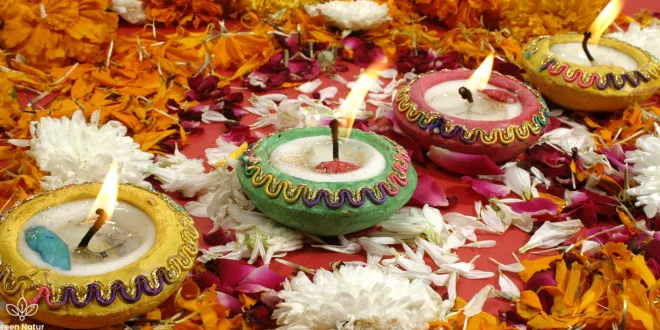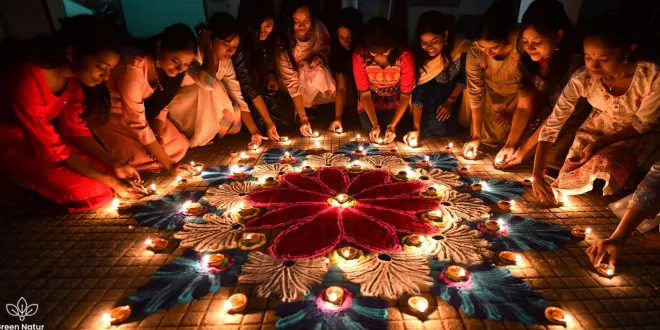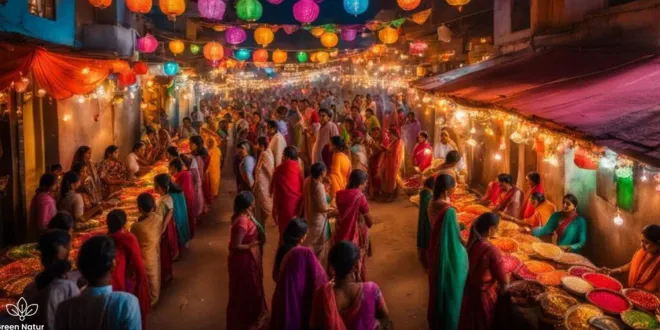India boasts a vibrant array of Indian festivals, each reflecting the country’s rich cultural heritage. From the dazzling lights of Diwali to the colorful joy of Holi, these festivals offer a unique insight into India’s traditions and spirituality. Celebrations like Durga Puja, Ganesh Chaturthi, and Pongal showcase the country’s diverse regional customs.
With deep cultural significance, Indian festivals unite communities in joy and devotion. Whether it’s the spiritual devotion of Navratri, the heartfelt prayers of Eid in India, or the grand feast of Onam, each festival offers a memorable experience.
Experiencing India’s festivals gives visitors a chance to witness the heart and soul of the country, with vibrant celebrations, music, food, and a spirit of unity.

Indian Festivals
-
Diwali
-
Holi
-
Ganesh Chaturthi
-
Navratri
-
Durga Puja
-
Pongal
-
Eid
-
Onam
Diwali – The Festival of Lights and New Beginnings
Among the most iconic Indian festivals, Diwali stands out as a celebration of light, victory, and renewal. Also known as the Festival of Lights, Diwali symbolizes the triumph of good over evil and light over darkness. Celebrated over five days across India, families decorate their homes with oil lamps (diyas), candles, and colorful rangoli patterns. Fireworks light up the skies, sweets are exchanged, and prayers are offered to Goddess Lakshmi for prosperity.
As part of the Diwali festival, shopping for new clothes, cleaning homes, and giving gifts are common traditions that mark new beginnings. Whether you are experiencing Diwali in Delhi, Jaipur, or a small village, the atmosphere is filled with warmth, joy, and a sense of togetherness.
This Indian cultural festival is not only deeply rooted in spirituality but also offers a vibrant window into India’s diversity. If you’re planning a cultural trip, Diwali is one of the best times to visit India and witness its traditions firsthand.
Holi – The Vibrant Festival of Colors and Joy
Holi festival, often referred to as the Festival of Colors, is one of the most joyful and visually stunning Indian festivals. Held every spring, Holi celebrates the arrival of a new season, love, laughter, and the triumph of good over evil, inspired by the legend of Prahlad and Holika.
During Holi celebrations, people take to the streets with colored powders, water balloons, and music, turning cities into a living rainbow. Friends, families, and even strangers joyfully smear each other with colors, dance to drum beats (dhol), and share traditional sweets like gujiya.
This celebration is especially popular among travelers seeking authentic cultural immersion. Holi isn’t just a color fight—it’s a deep-rooted expression of unity, joy, and rebirth. For anyone interested in Indian culture and traditions, experiencing Holi in India is unforgettable.
Ganesh Chaturthi – Honoring the Elephant-Headed God
Ganesh Chaturthi is another major event on the Indian festivals calendar, honoring Lord Ganesha, the beloved elephant-headed god of wisdom and new beginnings. This vibrant 10-day festival usually takes place in late August or early September, with the biggest celebrations occurring in Maharashtra, especially in Mumbai and Pune.
Families and communities install beautifully crafted Ganesha idols in homes and public spaces. Devotees perform prayers, sing devotional songs, and offer sweets like modaks, said to be Ganesha’s favorite. The festival concludes with a spectacular procession as the idols are immersed in rivers or the sea—a ritual called Visarjan.
Ganesh Chaturthi is not just a religious event, but a cultural experience that showcases community spirit, artistic creativity, and deep-rooted faith. For those exploring Indian cultural festivals, it offers a unique blend of devotion, festivity, and tradition.
Navratri – Nine Nights of Dance, Music, and Devotion
Navratri, which literally means “nine nights,” is a vibrant and spiritual Indian festival that honors the goddess Durga and her nine forms. Celebrated with great enthusiasm across India, especially in Gujarat and West Bengal, each night is marked by music, dance, and religious rituals.
In Gujarat, the highlight of Navratri celebrations is the Garba and Dandiya Raas—traditional group dances performed in colorful attire around a central altar. In West Bengal, the last four days overlap with Durga Puja, featuring dramatic idols, cultural shows, and devotional songs.
Navratri blends spiritual significance with social joy, making it a favorite for both locals and tourists. It’s a perfect time to witness how Indian culture celebrates the divine feminine through music, movement, and meaningful rituals. Among all Indian festivals, Navratri stands out as a fusion of faith and festivity.
Durga Puja – Celebrating the Victory of Good Over Evil
Among the grandest Indian festivals celebrated in eastern India, especially in West Bengal, Durga Puja honors the goddess Durga’s victory over the demon Mahishasura. Taking place in the lunar month of Ashwin (September–October), this multi-day festival is a spiritual and cultural spectacle.
During Durga Puja, elaborately crafted idols of the goddess are installed in beautifully decorated pandals (temporary temples), and each day involves rituals, prayers, food offerings, and traditional performances. The festival culminates with the immersion of the idols in rivers, symbolizing Durga’s return to her celestial abode.
For those exploring Indian culture and spirituality, Durga Puja offers a captivating experience of devotion, artistry, and regional pride. It is more than just a religious festival—it’s a social celebration of resilience, creativity, and faith.

Pongal – South India’s Thanksgiving Festival
Pongal festival is one of the most important Indian festivals in Tamil Nadu and other parts of South India. It is a harvest celebration held in mid-January, thanking the Sun God and nature for a bountiful harvest.
Spanning four days, Pongal includes rituals like boiling the first rice of the season (known as “Pongal” dish), decorating cows, and family gatherings. Homes are adorned with kolam (rice flour art), and traditional music and dances mark the festive mood.
As part of the wider Indian cultural festivals, Pongal reflects India’s deep-rooted connection to agriculture and community life. It’s a time of joy, gratitude, and renewal, drawing attention to the harmony between humans and nature.
Eid in India – A Blend of Culture and Spirituality
Though rooted in Islam, Eid celebrations in India have a unique cultural flavor. Both Eid al-Fitr (marking the end of Ramadan) and Eid al-Adha (Festival of Sacrifice) are widely observed by Muslims across the country and form an integral part of the Indian festivals calendar.
On Eid, communities come together for special prayers at mosques, followed by feasting, charity, and family gatherings. Traditional dishes like biryani, sheer khurma, and kebabs are shared with neighbors and friends, symbolizing togetherness and compassion.
For travelers and culture lovers, Eid in India offers a chance to witness communal harmony, delicious food, and rich Islamic traditions, all set within the broader mosaic of Indian culture.
Onam – Kerala’s Grand Cultural Festival
Onam festival is the most celebrated cultural event in the state of Kerala, and a must-see among regional Indian festivals. Rooted in Hindu mythology, it commemorates the homecoming of the legendary king Mahabali, who was beloved for his justice and prosperity.
The 10-day Onam celebration includes the famous Vallam Kali (snake boat races), Pookalam (floral carpet designs), traditional music and dance, and the grand vegetarian feast called Onasadya served on banana leaves.
Onam uniquely blends spirituality with community celebration, making it one of the most inclusive and joyful festivals in India. For anyone seeking to experience Indian cultural festivals at their finest, Onam is a perfect blend of tradition, hospitality, and visual beauty.

Conclusion
India’s festivals are not just celebrations; they are a window into the country’s soul. From the radiant lights of Diwali to the vibrant colors of Holi, each festival offers a unique cultural experience. Whether you’re exploring the spiritual depth of Durga Puja, the joyous community spirit of Onam, or the festive grandeur of Pongal, there’s always something to captivate every traveler’s heart.
By participating in these Indian festivals, you don’t just observe a tradition—you become part of it, embracing the joy, togetherness, and timeless customs that have been passed down through generations. So, if you’re planning a trip to India, make sure to time your visit with one of these iconic festivals to truly experience the magic of this incredible country.
Frequently Asked Questions
- What is the meaning of Diwali in India?
Diwali, the Festival of Lights, symbolizes the victory of good over evil and light over darkness. It is celebrated with fireworks, lights, and family gatherings. - How do people celebrate Holi in India?
Holi is celebrated by throwing colored powder at each other, singing, dancing, and enjoying festive foods, marking the arrival of spring and the triumph of good. - What are the rituals and customs of Ganesh Chaturthi?
People install idols of Lord Ganesha in homes and public spaces, offer prayers, sing devotional songs, and immerse the idols in water at the end of the festival. - Why is Durga Puja celebrated in India?
Durga Puja celebrates the victory of Goddess Durga over the demon Mahishasura, symbolizing the triumph of good over evil. It is especially celebrated in West Bengal. - When is the best time to visit India for festivals?
The best time to visit for festivals is during the months of October to March, when festivals like Diwali, Holi, and Durga Puja take place. - What is the significance of Pongal in South India?
Pongal is a harvest festival, particularly celebrated in Tamil Nadu, thanking the Sun God for a bountiful harvest. It includes rituals like cooking the first rice of the season. - How is Onam festival celebrated in Kerala?
Onam includes boat races, floral decorations (Pookalam), traditional dances (like Thiruvathira), and a grand feast called Onasadya, served on banana leaves. - What are the traditions of Eid celebrations in India?
Eid is marked by communal prayers, feasting, giving charity (Zakat), wearing new clothes, and spending time with family and friends after the month of Ramadan. - Why are festivals important in Indian culture?
Festivals in India celebrate spiritual beliefs, cultural traditions, and community bonding, uniting people from different walks of life in joy and celebration. - How long do the major festivals in India last?
Major festivals like Diwali, Durga Puja, and Navratri usually last 5 to 10 days, while Holi and Eid are celebrated in a day or two.

